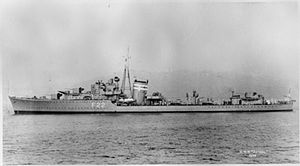HMS Jackal (F22)

HMS Jackal in May 1939
|
|
| History | |
|---|---|
|
|
|
| Name: | Jackal |
| Builder: | John Brown & Company, Clydebank |
| Laid down: | 24 September 1937 |
| Launched: | 25 October 1938 |
| Commissioned: | 13 April 1939 |
| Identification: | Pennant number: F22 |
| Fate: | Damaged by the Luftwaffe's Lehrgeschwader 1 and scuttled at 36°30′N 26°30′E / 36.500°N 26.500°E |
| General characteristics (as built) | |
| Class and type: | J-class destroyer |
| Displacement: | |
| Length: | 356 ft 6 in (108.66 m) o/a |
| Beam: | 35 ft 9 in (10.90 m) |
| Draught: | 12 ft 6 in (3.81 m) (deep) |
| Installed power: |
|
| Propulsion: | 2 × shafts; 2 × geared steam turbines |
| Speed: | 36 knots (67 km/h; 41 mph) |
| Range: | 5,500 nmi (10,200 km; 6,300 mi) at 15 knots (28 km/h; 17 mph) |
| Complement: | 183 (218 for flotilla leaders) |
| Sensors and processing systems: |
ASDIC |
| Armament: |
|
HMS Jackal was a J-class destroyer of the Royal Navy. Completed in 1939, Jackal served in the Norwegian campaign and the Dunkirk evacuation before being deployed to the Mediterranean in 1941. Jackal took part in the Battle of Crete, and was scuttled after being heavily damaged by German bombers on 12 May 1942.
HMS Jackal was ordered, along with the rest of the J class, on 25 May 1937, and was laid down by John Brown and Company, Limited, at Clydebank in Scotland on 24 September 1937, launched on 25 October 1938 and commissioned on 13 April 1939, the first of the J class to be completed.
As completed, Jackal had a main gun armament of six 4.7 in (120 mm) QF Mark XII guns in three twin mountings, two forward and one aft. These guns could only elevate to an angle of 40 degrees, and so were of limited use in the anti-aircraft role, while the aft mount was arranged so that it could fire forwards over the ship's superstructure to maximise the forward firing firepower, but was therefore incapable of firing directly aft. A short range anti-aircraft armament of a four-barrelled 2 pounder "pom-pom" anti-aircraft mount and eight .50 in machine guns in two quadruple mounts was fitted, while torpedo armament consisted of ten 21 inches (533 mm) torpedo tubes in two quintuple mounts.
In an attempt to strengthen its anti-aircraft armament, one of Jackal's banks of torpedo tubes was removed in favour of a single 4 inch Mk V anti-aircraft gun, while four Oerlikon 20 mm cannon replaced the .50 in machine guns.
On the outbreak of the Second World War, Jackal joined the 7th Destroyer Flotilla, part of the Royal Navy's Home Fleet, carrying out anti-submarine patrols and convoy escort missions in the North Sea, English Channel and the Western Approaches in the remainder of 1939 and the early months of 1940. On 28 February 1940, Jackal was badly damaged in a collision with the Swedish merchant ship Storfors (which was sunk), and was under repair at Blyth Shipbuilding Company, Northumberland until April 1940.
...
Wikipedia
